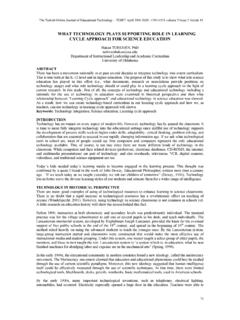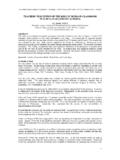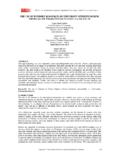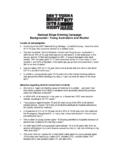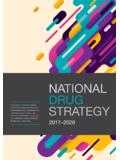Transcription of Attitudes of Students and Teachers towards the …
1 TOJET: The Turkish Online Journal of Educational Technology April 2015, volume 14 issue 2 Copyright The Turkish Online Journal of Educational Technology 15 Attitudes of Students and Teachers towards the Use of Interactive Whiteboards in Elementary and Secondary School Classrooms Nuri Balta Canik Basari University, Samsun/TURKEY Muharrem Duran Bozok University, Yozgat/TURKEY ABSTRACT Recently much have been invested in the interactive whiteboard educational technology in Turkey. The government is still wishful to spread it to schools of all levels. This study tries to understand Teachers and Students Attitudes toward interactive whiteboard technology along with differences in Attitudes resulting from some demographic factors. Two parallel surveys consisting of 25 items were applied to 255 Students and 23 Teachers from three private schools. Students from sixth to twelfth grades and Teachers from 15 different branches participated in this research study.
2 The results indicate that interactive whiteboards are highly rated by both Teachers and Students . Students mostly prefer the usage of interactive whiteboards in math courses, and their Attitudes differ across their genders and school levels. As Students get elder, their positive Attitudes toward interactive whiteboard technology decrease, and it has been found out that there is no difference between Teachers and Students Attitudes . This study includes some implications for policy makers, educator and researchers. Keywords: interactive whiteboard, student attitude, teacher attitude, ICT technology INTRODUCTION An interactive whiteboard is an instructional tool that is connected to a computer and a projector and enables the transfer of images from computer to the board. Thus, the instructor can control the related items directly on the screen with a pen or finger. The lecturer can perform various actions with interactive whiteboards such as dragging, clicking, pasting and copying items; taking handwrite notes, transforming them into texts and highlighting those texts; adding annotations, notes and drawings and saving them to be printed out and shared; showing picture animations and educational videos to the whole class; saving and recalling current and previous screens, revisiting, reviewing and amending when required; using contents available on a website.
3 Most of the studies in the written literature report extremely positive perceptions about the effects and the potential of interactive whiteboard technology (Elaziz, 2008). For instance, many studies report the positive effect of interactive whiteboards on Students success (Holmes, 2009; Lewin, Somekh & Steadman, 2008; Marzano, & Haystead, 2009; Thompson, & Flecknoe, 2003; Yang, Wang, & Kao, 2012; Yorganc , & Terzio lu, 2013). A study conducted by Yang, Wang, & Kao (2012) can be cited as an example for the effects of interactive whiteboards on Students success. They designed a quasi-experimental design with sixth-grade Students to understand how interactive whiteboards influence Students learning. In their study, two different work groups were designed. One of these groups (n=59) studied in an environment using interactive whiteboards during the teaching process, while the other group (n=59) studied in an environment using conventional information technologies.
4 They showed that Students in the first group learned more productively than those in the second group. Besides such studies that show the positive effects of using whiteboards in teaching on Students success, there are some other studies that report the effect of interactive whiteboards as negligible (Glover, Miller, Averis, & Door, 2005; Higgins, Beauchamp, & Miller, 2007; Solvie, 2007). Many Teachers regard interactive whiteboards as valuable teaching tools (Warwick & Kershner, 2008). Interactive whiteboards enable Teachers to design and organize activities and lessons using a broad variety of multimodal resources and to engage Students cognitive and innovative potentials into the learning process (Littleton, Twiner, & Gillen, 2010). In addition, interactive whiteboards can be used to deliver the instructions to the Students effectively (DeSantis, 2012).
5 As powerful technological devices, interactive whiteboards have the potential to help Teachers convert the ordinary classroom conditions into a student-centered collective environment (Somyurek, Atasoy & Ozdemir, 2009). The use of interactive whiteboards in classrooms contributes to the learning process through increasing the Teachers proficiency level, facilitating student-centered instructional performances and changing many experienced Teachers Attitudes toward technology TOJET: The Turkish Online Journal of Educational Technology April 2015, volume 14 issue 2 Copyright The Turkish Online Journal of Educational Technology 16 (Huber, 2010). Teachers can procure vast digital educational materials through instant access to the Internet and present them to Students via interactive whiteboards. Current research on the interactive whiteboards use in educational settings reflects several advantages for Students .
6 For instance, they develop Students autonomy (Harlow, Cowie, & Heazlewood, 2010; Minor, Losike-Sedimo, Reglin & Royster, 2013) and it has been discussed that they increase student enthusiasm and motivation (Schmid, 2006; Torff & Tirotta 2010; Wood, R., & Ashfield, J. (2008), possess the capacity to ease teaching and learning (Smith et al., 2005; Glover et al 2005), enhance the degree of understanding (Holmes 2009; Wall, Higgins & Smith, 2005) and enable Students to participate in the lessons being conducted and provide collaboration in the classroom (Gray et al., 2005; Minor, Losike-Sedimo, Reglin & Royster, 2013). Information and communication technology (ICT) in education is widely used for effective learning throughout the world. As a type of ICT, interactive whiteboards have so many benefits. Due to this potential, many countries have invested considerably in the installation of interactive whiteboards and struggled to spread this technology to schools of all levels.)
7 In terms of installation of interactive whiteboards in schools, the United Kingdom (UK) has made the greatest attempt (Yang, Wang, & Kao, 2012). In many UK primary schools, other teaching tools have almost been completely replaced with interactive whiteboards (Warwick, Hennessy, & Mercer, 2011). In reference to BECTA (2007), the interactive whiteboards has a high prevalence in primary (100%) and secondary schools (98%) of UK. In Turkey, more than $1 billion have been invested for the development of the elementary and secondary education programs (Somyurek, Atasoy & Ozdemir, 2009). This investment were made in accordance with FAT H Project (The Increasing Opportunities and Improvement of Technology Movement) which was initiated with National Science and Technology Policy 2003-2023 Strategy Document, in November 2010. The aim of this project was to provide equality of educational opportunities in Turkish schools and the most productive usage of information technologies.
8 With this project, it was aimed to provide 570000 LCD Panels and internet network infrastructure in all classrooms of preschool, elementary and secondary education (FAT H, 2014). Many countries, including USA, Canada, Mexico Taiwan, Japan, Singapore, Malaysia, China and Russia are also aware of the importance of using this technology in classroom teaching, and all these countries are eager to integrate interactive whiteboards in learning and teaching (Yang, Wang, & Kao, 2012). At the end of 2009, interactive whiteboards were installed in 31% of Australian classrooms, 40-42% of classrooms of Denmark and The Netherlands were equipped with interactive whiteboards as well (Lee, 2010). Significance of the Problem According to Heuser (2005), interactive whiteboards are used in more than million K-12 classrooms, by more than 40 million Students globally." Since the FAT H project was initiated in Turkey, billions of dollars have been consumed in supplying schools with the interactive whiteboards, computers and Internet.
9 Even though Turkey is one of the countries that invest a great deal in interactive whiteboard technology, there is comparatively fewer background or research literature available on interactive whiteboards than the other countries. Most of the studies conducted in Turkey related to interactive whiteboards are about participants views (Bulut & Ko o lu, 2012; G rol, Donmu , & Arslan, 2012; Kahyao lu, 2011) and about the problems that Teachers and administrators encounter during the use and placement of the boards ( ift i, Ta kaya, & Alemdar, 2013; Keser, & etinkaya, 2013; (Somyurek, Atasoy & Ozdemir, 2009; T rel, 2012). As the quantity of interactive whiteboards in Turkish classrooms is increasing, the productivity of these devices and Attitudes toward them in promoting teaching and learning will continue to be questioned. Moreover, as Teachers use interactive whiteboards, the attention will turn to pedagogical issues and the attitude towards these boards.)
10 Although many countries/schools have enthusiastically adopted interactive whiteboards, only few negative Attitudes have been detected against these boards. Since the literature s lack of studies investigating Students and Teachers Attitudes towards interactive whiteboards technology (Elaziz, 2008), this study may provide useful results for the literature especially showing how Teachers and Students perceive interactive whiteboard technology. Before deciding whether to invest in a new technology or available technologies to screen the current system, policy makers and educators need to know views of education s shareholders such as Teachers and Students who are to use this technology in the first place. Further research that will include the other shareholders of education like parents/guardians, administrators and other facilitators are a need, especially in Turkey and would be valuable.

